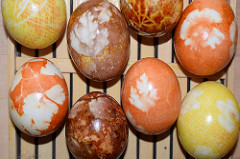The Easter Egg. Tradition and History.
Easter is just around the corner. Have you ever wondered why the Easter egg became such an important part of Easter? Have you wondered where our tradition of coloring eggs came from? Read on and learn a bit of Easter lore and learn how to make your own naturally dyed Easter eggs and family traditions.
The Eggs’ Symbolism in History
Many ancient cultures such as the Hindus, Egyptians and Persians believed the world began with a giant egg. For these cultures the egg came to symbolize new and emerging life that has been around for billions of years. The egg is a symbol of life and rebirth for cultures all around the world. Many of our accepted Easter customs have their root in pagan traditions as well. Since Easter is always in the spring, many cultures celebrate Easter as a time of renewal after a long dark winter. It is believed that our pagan ancestors, derived the word “Easter” from the pagan goddess Eostres, the divinity of the radiant dawn, of upspringing light. Spring is the time of the growing sun and new birth. So naturally the egg has evolved as a symbol of Spring’s arrival.
The Colored Egg and Easter Celebration
In the Christian tradition the Easter egg represents Christ’s rising and his emergence from the tomb. We first saw this mentioned in ancient texts 500 years ago. The Mesopotamians were the first Christians to color their eggs using red dyes to represent the blood of Christ. Ancient cultures used a variety of colors derived from the natural dyes in plants to color their eggs. In some cultures flowers or leaves were placed onto the shell before dying to create beautiful patterns. Eastern European countries used beeswax to create designs before coloring the eggs to create intricate patterns.
In the Christian tradition, during the 4o days of lent, people did not eat meat or eggs. By the time Easter came Christians were ready to celebrate by coloring and feasting on their eggs. There was also an over abundance of eggs as the hens continued to lay them during lent when the Christians were abstaining. Therefore, many of the customary Easter dishes such as egg breads were used for celebration.
Easter Eggs and Games
As Americans we are all familiar with the quintessential Easter egg hunt. However, other countries have different traditions using the Easter egg. In some European cultures children go house to house asking for eggs, similar to our Halloween. Another game is the Easter egg roll. The egg rolling is a symbolic re-enactment of the rolling away of the stone from Christ’s tomb. Different counties have their own rules. In Germany children roll their eggs down a stick track while in the United States children push their egg with a wooden spoon. In the United States the White House Easter Egg Roll is a tradition that dates back to 1878 under the leadership of President Rutherford B. Hayes.
Other Easter Symbols … Bunnies, Chicks and the Easter Lily
Eggs are not the only symbol of Easter. Bunnies, baby chicks, and lily flowers all symbolize rebirth and have become part of our Easter celebration over the centuries. The Easter bunny arose as a symbol of fertility due to their prolific production of off spring. Baby chicks represent rebirth as they crack from the stillness of their shell to an explosion of life . Lilies are one of the first flowers to bloom in the spring bringing color and the renewal of life to the world.
Now that you have a little Easter history under your belt. Learn how to make your own naturally dyed European (Swiss) Easter eggs as in the photo at the top of this blog post. Make it a fun family and friends project day. Visit our Natural Dyed Eggs blog page and Natural dyed egg seed bomb photo essay page to learn more about techniques, crafts and recipes. You can also view our YouTube video below to see some of our most spectacular Easter eggs from our test kitchen.
Read our 2014 Easter Egg press release in MarketWatch


